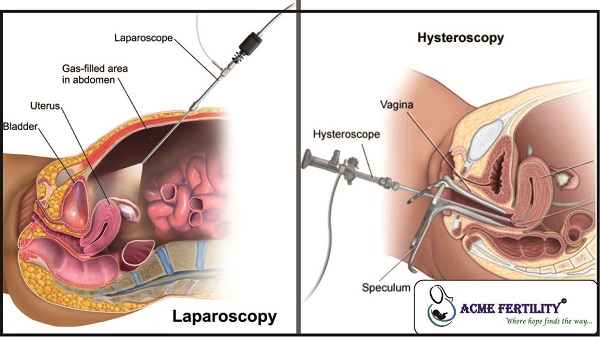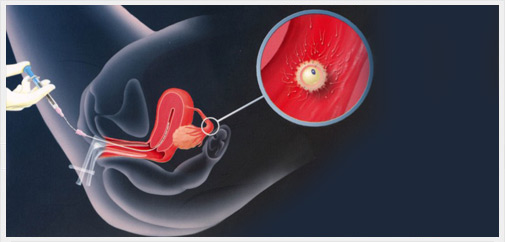Laparoscopic surgery, also called minimally invasive surgery (MIS), bandaid surgery, or keyhole surgery, is a modern surgical technique in which operations in the abdomen are performed through small incisions (usually 0.5–1.5 cm) as opposed to the larger incisions needed in laparotomy. Keyhole surgery makes use of images displayed on TV monitors to magnify the surgical elements.
Laparoscopic surgery includes operations within the abdominal or pelvic cavities, There are a number of advantages to the patient with laparoscopic surgery versus an open procedure. These include reduced pain due to smaller incisions and hemorrhaging, and shorter recovery time.
The key element in laparoscopic surgery is the use of a laparoscope. A digital laparoscope where the charge-coupled device is placed at the end of the laparoscope, Also attached is a fiber optic cable system connected to a ‘cold’ light source (halogen or xenonto illuminate the operative field, inserted through a 5 mm or 10 mm cannula or trocar to view the operative field. The abdomen is usually insufflated, or essentially blown up like a balloon, with carbon dioxide gas. This elevates the abdominal wall above the internal organs like a dome to create a working and viewing space. CO2 is used because it is common to the human body and can be absorbed by tissue and removed by the respiratory system. It is also non-flammable, which is important because electrosurgical devices are commonly used in laparoscopic procedures.
A. Indications of Laparoscopy:
- 1. Check for and possibly take out abnormal growths (such as tumors) in the belly or pelvis ex. fibroid uterus, ovarian cysts etc.
- 2. Check for and treat conditions such as endometriosis, ectopic pregnancy, or pelvic inflammatory disease (PID).
- 3. Find conditions that can cause infertility. These conditions include cysts, adhesions, fibroids, and infection.
- 4. Laparoscopy may be done after initial infertility tests do not show the cause for the infertility.
- 5. Do a biopsy.
- 6. See whether cancer in another area of the body has spread to the belly.
- 7. To do a tubal ligation.
- 8. Fix a hiatal hernia or an inguinal hernia.
- 9. Take out organs, such as the uterus,(Hysterectomy), fallopian tubes and ovaries (salpingoophorectomy)
- 10. Find the cause of sudden or ongoing pelvic pain.
B. Procedure –
Laparoscopy is done by a gynecologist surgeon. General anesthesia is generally used, but other types of anesthesia, such as spinal anesthesia, may be used. About an hour before the surgery, you will empty your bladder. You will get fluids and medicine through an intravenous (IV) in a vein in your arm. You may get a medicine (sedative) to help you relax..
Several procedures may be done after you get your anesthesia and are relaxed or asleep.
- 1. An airway will be placed in your throat to help you breathe if you get general anesthesia.
- 2. A thin flexible tube (urinary catheter) may be put through your urethra into the bladder.
- 3. Your surgical area will be washed with a special antiseptic solution.
During laparoscopy, a small incision is made in the belly. More than one incision may be made if other tools will be used during the surgery. A hollow needle is put through the first incision and gas (carbon dioxide or nitrous oxide) is slowly put through the needle to inflate the belly. The gas lifts the abdominal wall away from the organs inside so your doctor can see clearly. A thin, lighted tube (laparoscope) is then put through the incision to look at the organs. Other tools can be used to take tissue samples, fix damage, or drain cysts. After the surgery, all the tools will be removed and the gas will be released. The incisions will be closed with stitches and covered with a bandage. The scar will be very small and will fade over time
Laparoscopy takes 30 to 90 minutes, depending on what is done, but can take longer if a condition (such as endometriosis) is found and treated. After the laparoscopy, you will go to the recovery room for 2 to 4 hours. You can usually do your normal activities the next day, but do not do any strenuous activity or exercise for about a week.




Great content! Super high-quality! Keep it up! 🙂
Wow, awesome blog format! How long have you ever been running a blog for? you made blogging glance easy. The full look of your site is fantastic, as well as the content!!
Wow, superb weblog layout! How lengthy have you been running a blog for? you make running a blog glance easy. The overall glance of your site is great, as well as the content material!!
Wow, incredible blog layout! How lengthy have you ever been blogging for? you make blogging look easy. The total look of your website is magnificent, as neatly as the content material!!
Wow, superb blog layout! How long have you ever been running a blog for? you made blogging glance easy. The overall glance of your website is great, let alone the content material!!
Wonderful material! What a fascinating way to organize the texts of articles and pages.
I love it, it’s awesome! But I prefer adult sites. Porn films
and pornstars are full of adolescent sex. The biggest female booty asses
that are arouse many men. And their irritated vaginas.
Mmmmmmmmm! I really want hot chubby chicks naked.
Have you seen the stunning big a$$holes? These articles
are all written in great detail about women with
big butts and free sex mivies.
Good post. I learn something totally new and challenging on blogs I stumbleupon every day. It will always be interesting to read through articles from other writers and use a little something from other sites.